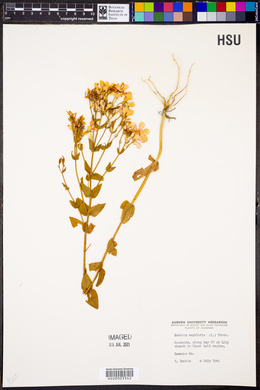Sabatia angularis
|
|
|
|
Family: Gentianaceae
Rose-Pink, more...rosepink, squarestem rosegentian
[Sabatia angularis f. albiflora Raf. ex House] |
Stout biennial, 3-8 dm, commonly with many opposite branches at and beyond the middle, sharply wing-angled; lvs ovate or lance-ovate, 1-4 cm, broadly rounded or subcordate at base, 3-7-nerved; pedicels 5-30 mm, the conspicuous wings continuing upon the base of the cal; cal-lobes narrowly oblong to oblanceolate, 6-15 mm, usually at least 1.5 mm wide; cor pink (white) with a greenish center, the lobes 1-2 cm, oblanceolate to obovate; 2n=38. In a wide range of habitats, sometimes weedy; Conn. to s. Mich. and Kans., s. to Fla. and Tex. July, Aug. Gleason, Henry A. & Cronquist, Arthur J. 1991. Manual of vascular plants of northeastern United States and adjacent Canada. lxxv + 910 pp. ©The New York Botanical Garden. All rights reserved. Used by permission. Annual or biennial herb 20 cm - 0.8 m tall Stem: stout, hollow, green or straw-colored below, strongly and sharply four-angled or winged, and normally bushy-branched with many opposite branches at and beyond the middle. Inflorescence: of numerous, mostly opposite, 0.5 - 3 cm long branches ending in single flowers, or small groups of flowers. The inflorescence branches have conspicuous wings, which continue up onto the base of the flower sepal tube. Flowers: delicately fragrant, radially symmetric, 1.8 - 3.4 cm wide, greenish in bud, paler beneath, but turning rosey-pink (sometimes white) with a greenish-yellow center. Sepals: five, but fused at base into a shallow cup with short ridges or wings along the outside at the very bottom. The separate sepal lobes are linear, only 1.5 - 2.3 mm wide, 4 - 15 mm long, or about half the length of the petals. Petals: five, but fused into a short (4 - 7 mm long) tube, then separating into spreading, 1 - 2 cm long, oblong or inversely egg-shaped lobes with rounded tips. The petal lobes have oblong or inversely egg-shaped yellow spots at their bases, which are usually bordered by a dark red line, but no glands are present. Stamens: five, with greenish yellow, 2.5 - 4.5 mm long filaments ending in bright yellow, 3 - 5 mm long, slender anthers. Pistil: with a single-chambered, superior ovary; a well-developed (4 - 6 mm long) style greater than or equal to one-fourth the length of the ovary; and two, 3 - 6 mm long, slender stigma lobes. Fruit: a many-seeded, single-chambered, 5 - 9 mm long (about the same length as the linear sepal lobes), 4 - 6 mm wide, cylindric capsule. Basal leaves: inversely egg-shaped, non-toothed, somewhat persistent in a rosette, although usually absent by flowering time (as are lower stem leaves). Stem leaves: opposite, stalkless, non-toothed, egg-shaped with a broadly rounded or heart-shaped clasping base. The leaves are relatively thin in texture, and have three to seven visible and raised nerves on the leaf underside. Similar species: Sabatia angularis is quite similar to S. campestris (though it is now believed extinct in our area), but that species is an annual lacking basal rosette leaves, the branches of the inflorescence are mostly alternate, the fused sepal tube is longer and has very strong wings or ridges running up its outer sides, and although it has a noticeably angled stem, there are no wings. The other similar species, S. campanulata, has a very restricted distribution (only in one county in the Chicago Region) and differs because it is a perennial, the stems are round in cross-section, the leaves do not clasp the stem at their bases, and the fused sepal tube is shorter (about as tall as broad), not angled, and thin and papery in texture, rather than green. Flowering: July to October Habitat and ecology: Typically restricted to sandy shores of pannes (interdunal ponds) or other calcareous pond shores, especially near Lake Michigan. Occurence in the Chicago region: native Notes: The distribution of species within this genus is centered in the Atlantic Coastal Plain with only a few species reaching into the Chicago Region. Sabatia angularis is the only species expected to be seen with any regularity here (but only in the correct habitat). This also happens to be the most widespread of the species in this genus. Etymology: Sabatia is named after Liberato Sabbati, an Italian botanist from the mid-1700's. Angularis is the Latin word for "having angles or corners", referring to the sharp angles on the stems. Author: The Field Museum From Flora of Indiana (1940) by Charles C. Deam In Indiana this plant has two distinct habitats. In the lake area, including our Henry County specimen, all of our specimens with one exception were found on the moist sandy or peaty borders of lakes and swamps. In 1938 I found it to be a common plant on an open, pastured black and white oak ridge a half mile northwest of Disko, Fulton County. In the southern part of the state this species is frequent to common in hard, dry, clay soil in old fallow fields and in this habitat it reaches its greatest size. It is also infrequently found on exposed open places on the crests or slopes of wooded ridges. …… Indiana Coefficient of Conservatism: C = 3 Wetland Indicator Status: FAC |
|
|
|






















































































